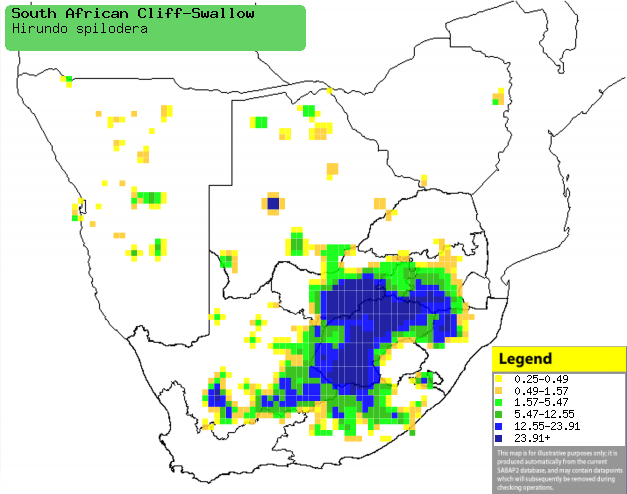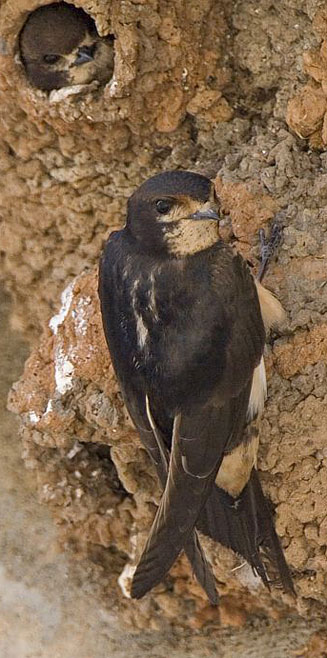|
Hirundo spilodera (South African
cliff-swallow)
Familieswael [Afrikaans]; Sisampamema (generic term for
swallows, martins, swifts and spinetails) [Kwangali]; Lefokotsane (generic term
for swallow) [South Sotho]; Pęolwane, Phętla (generic terms for swifts,
martins and swallows) [Tswana]; Kaapse klifzwaluw [Dutch]; Hirondelle
sud-africaine [French]; Klippenschwalbe [German]; Andorinha-sul-africana
[Portuguese]
Life
> Eukaryotes >
Opisthokonta
> Metazoa (animals) >
Bilateria >
Deuterostomia > Chordata >
Craniata > Vertebrata (vertebrates) > Gnathostomata (jawed
vertebrates) > Teleostomi (teleost fish) > Osteichthyes (bony fish) > Class:
Sarcopterygii (lobe-finned
fish) > Stegocephalia (terrestrial
vertebrates) > Tetrapoda
(four-legged vertebrates) > Reptiliomorpha > Amniota >
Reptilia (reptiles) >
Romeriida > Diapsida > Archosauromorpha > Archosauria >
Dinosauria
(dinosaurs) > Saurischia > Theropoda (bipedal predatory dinosaurs) >
Coelurosauria > Maniraptora > Aves
(birds) >
Order: Passeriformes > Family: Hirundinidae
Distribution and habitat
The non-breeding season is mainly spent in western DRC,
flying to South Africa for the breeding season. It also has localised breeding
populations in eastern Zimbabwe, Namibia and possibly south-eastern Botswana,
with other records from Botswana and Namibia probably just stop off points on
the way to the colonies. In South Africa it is common in the Free State
Province, North-West Province, Mpumalanga, Gauteng, northern KZN, Eastern Cape
and southern Northern Province. It generally prefers grassland, open savanna and
Karoo.
|
 |
|
Distribution of South African cliff-swallow in
southern Africa, based on statistical smoothing of the records from
first SA Bird Atlas Project (©
Animal Demography unit, University of
Cape Town; smoothing by Birgit Erni and Francesca Little). Colours range
from dark blue (most common) through to yellow (least common).
See here for the latest distribution
from the SABAP2. |
Predators and parasites
- Predators of the chicks
- Parasites (all only occurring on this species)
- Ornithomya inocellata (fly)
- Xenopsylla trispinis (flea)
- Ornithodoros peringueyi (tick)
Movements and migrations
Intra-African breeding migrant, usually
arriving from its DRC non-breeding grounds around early August,
leaving around late April.
Food
It eats a variety of aerial and flightless insects, usually
foraging less 3 metres above ground. It often hovers above a bush to flush
insects, or alternatively it catches prey disturbed by grass fires, ploughs,
sheep, cattle, Helmeted guineafowl,
Cattle egret or
Common ostrich. It may also descend to the
ground to feed on Northern harvester termites (Hodotermes mossambicus)
and other insects. The following food items have been recorded
in its diet:
Breeding
- Monogamous, colonial nester, with colonies comprising 20 to upwards of 900
nests, often adjacent to Little swift
colonies. Individual pairs defend a small territory around the nest entrance
against other pairs.
- The nest (see image below) is a gourd-shaped structure with a short
entrance tunnel, built of mud pellets and lined wool, plant down and
feathers. The entrance holes are packed tightly together, often often
overlapping as in the photo. A horizontal ridge is often placed below the
entrance which is lengthened as more nests are constructed. It is almost
always placed in artificial site since the 1800s, such as in traditional
huts and bridges but rarely on cliffs.
 |
|
| South African cliff-swallows at nest,
Bloemfontein, South Africa. [photo
Trevor Hardaker ©] |
|
- Egg-laying season is from August-February, peaking around
November-December.
- It usually lays two separate clutches per breeding season, each
consisting of 1-4, usually 2-3 eggs. They are incubated by both sexes for
approximately 14-16 days, in shifts of 1-27 minutes.
- The chicks are fed by both parents, leaving the nest after about 23-26
days, but it can be delayed if the chick is too heavy to fly. The juveniles
return to the nest to roost for at least 4 days, often lured there by there
with calling and coaxing by their parents.
Threats
Not threatened, in fact its range has benefited from the
introduction of man-made nest sites, which it now uses almost exclusively.
References
-
Hockey PAR, Dean WRJ and Ryan PG 2005. Roberts
- Birds of southern Africa, VIIth ed. The Trustees of the John Voelcker
Bird Book Fund, Cape Town.
-
Harrison, J.A., Allan, D.G., Underhill, L.G., Herremans, M.,
Tree. A.J., Parker, V. & Brown, C.J. (eds). 1997. The atlas of southern
African birds. Vol. 2: Passerines. BirdLife South Africa, Johannesburg.
|
